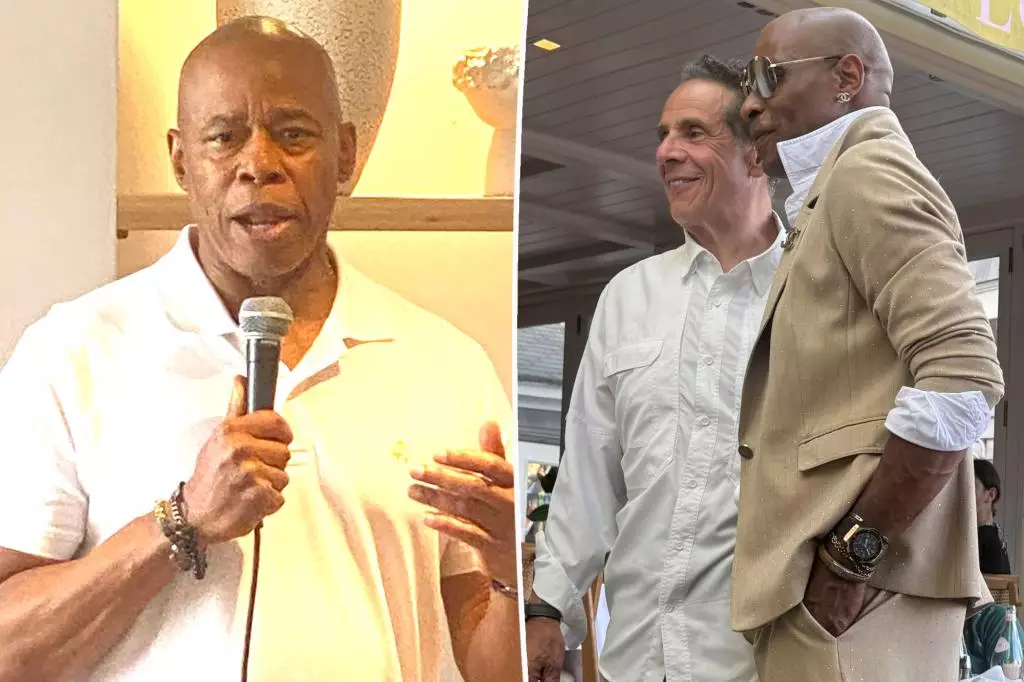The picturesque enclave of the Hamptons has long been associated with leisure, luxury, and summer retreats for the elite. However, recent weekends have transformed this tranquil setting into a bustling battleground for political influence and ambition. Behind gated estates and seaside charm, a strategic dance unfolds among powerful figures eager to cement their dominance in New York’s political landscape. The convergence of Mayor Eric Adams and former Governor Andrew Cuomo in the same upscale locale epitomizes this complex game, revealing a deeper narrative about leadership, loyalty, and the race for relevance.
The presence of Adams and Cuomo in the Hamptons signifies far more than mere leisure; it underscores the importance of symbolic gestures in politics. For Adams, appearing at high-profile fundraisers, engaging with influential donors, and recounting tales of resilience puts him squarely in the narrative of strength and determination. Conversely, Cuomo’s casual dining and attendance at exclusive gatherings suggest a calculated effort to stay visible, hinting at lingering ambitions despite recent electoral setbacks. The Hamptons, traditionally an apolitical playground, has thus become a stage for subtle power plays, with each figure vying for the perception of strength and influence.
Adams’ Bold Campaign Rhetoric: A Fight to Reclaim Authority
Mayor Eric Adams’s speech at the “Hamptons Business Power Breakfast” was more than just an affirmation of political ideology; it was a declaration of resilience. Invoking hockey legend Wayne Gretzky, Adams attempted to craft an image of perseverance amidst adversity. His story about the Edmonton Oilers battling exhaustion in a grueling playoff series served as a metaphor for his approach to leadership—ready to fight relentlessly for his city despite intense scrutiny and scandal.
Adams’s targeting of far-left ideologies and his assertion of authority over New York’s safety signal a combative style of politics. His references to “keeping New York safe” reflect an effort to rally support amid internal and external challenges. Additionally, his direct critique of Democratic rival Zohran Mamdani, claiming that the politician’s claims of African American heritage are questionable and that his proposals are doomed without state backing, reveals a candid, aggressive stance aimed at consolidating his base. Adams’s strategy seems rooted in establishing himself as a resilient protector, willing to confront not only political opponents but also ideological enemies threatening the city’s progress.
Moreover, Adams’s emphasis on humility—dining with cooks and dishwashers to appreciate the backbone of the city—complements his combative rhetoric. It is a calculated move to project authenticity and a connection to grassroots workers, placing him in the tradition of leaders who champion the everyday person. Yet, critics argue that these humble gestures are just as much about image-building as genuine concern, exposing a tendency to manipulate symbolism for political gain.
Cuomo’s Ongoing Search for Relevance
Andrew Cuomo’s appearance in the Hamptons signals a different, but equally strategic, form of political positioning. The former governor’s casual presence—dining in the same upscale restaurant, attending social parties—demonstrates his effort to stay within the public eye. Despite his surprising primary defeat, Cuomo remains an active figure, allegedly contemplating a run for mayor amid skepticism and ambivalence from his supporters.
While Cuomo’s political ambitions are less transparent, his frequent presence at high-profile social events suggests a desire to remain relevant. His attendance at Lally Weymouth’s annual birthday bash and Fourth of July festivities demonstrates an understanding that political capital is often built in informal settings among the influential. The fact that Cuomo has been spotted sporadically in the Bronx and Brooklyn, engaging with voters and gauging support, indicates he’s not entirely resigned to retirement. Instead, he appears to be reevaluating his options, weighing the potential of a political comeback in New York City’s mayoral race.
This ongoing ambiguity reflects Cuomo’s complex relationship with the public—simultaneously a political survivor and a controversial figure. His connections to top-tier insiders, combined with his history of leadership, make him a lingering threat or ally depending on the vantage point. What remains clear is that Cuomo’s presence in the Hamptons signifies an attempt to remain a relevant force in the city’s political chessboard, even if the path to reclaiming power is fraught with obstacles.
The Power Dynamics Behind the Scenes
The political narrative in the Hamptons exposes the fragility and opportunism that underpin New York’s elite circles. Events like the “Hamptons Business Power Breakfast” and the fundraising at the Fishel estate are more than social gatherings—they are meticulously orchestrated opportunities to cultivate loyalty, secure financial backing, and sway influential public figures.
The involvement of billionaires, political insiders, and media moguls highlights the intertwined nature of wealth and power in modern politics. For instance, John Catsimatidis’s role as a co-host emphasizes the importance of financial support and networking among the wealthy elite. Similarly, the Tunnel to Towers gala’s focus on honoring veterans underscores an image of patriotism and community service that can be leveraged politically.
The shifting allegiances and visible jockeying between Adams and Cuomo also illustrate the volatile landscape of New York politics. With Adams actively campaigning to solidify his base and Cuomo contemplating a comeback, the subtle but decisive interactions at these events reveal the underlying tension. They serve as platforms where reputations are built, alliances are tested, and the future direction of leadership in the city is silently negotiated.
The convergence of Kate political ambitions, the spectacle of elite social events, and the strategic positioning of figures like Adams and Cuomo in the Hamptons underscore a broader truth: New York’s power corridors remain fiercely contested, even among its most privileged. This weekend’s activities are more than idle leisure—they are mirror images of the city’s ongoing struggle to define its identity, leadership, and future. Behind the sun-drenched facades and lavish gatherings, a battle for influence, legacy, and control rages silently, shaping the destiny of one of the world’s most dynamic and divided metropolitan hubs.

